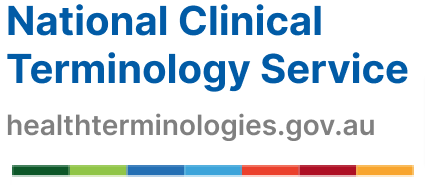Uses of SNOMED CT
SNOMED CT is the most comprehensive, multilingual clinical healthcare terminology in the world. It’s also the preferred national standard for clinical terminology in Australia.
Record clinical data at the point of care
SNOMED CT can be used to record data in clinical information systems. It allows clinicians to record precise and accurate information for patient care.
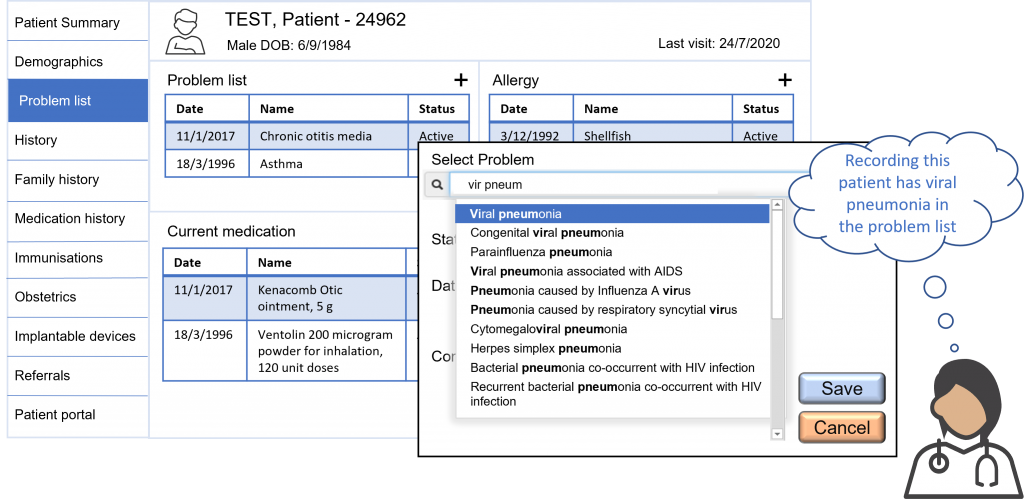
This diagram shows how a doctor enters data into electronic health record (EHR) software using SNOMED CT.
The doctor starts typing medical terms which are displayed on the screen. The software suggests terms matching the sequence of letters typed by the doctor. The doctor selects clinical terms that have a corresponding SNOMED CT code in the backend.
The doctor is able to record the patient’s problems, allergies, tests and medications in a form that is:
- precise
- clear
- linked to related concepts (in the backend)
- commonly understood by other health professionals
- able to be read and interpreted by computers.
The doctor may not have been aware they were using SNOMED CT to record the patient data because the terminology used by the system has been set up in the backend.

In action
NSW Health is using SNOMED CT within electronic medical record software called Cerner Millennium.
The Royal Australasian College of Surgeons is using SNOMED CT to record data about operations within its Morbidity Audit and Logbook Tool (MALT).
Sharing clinical data between systems
SNOMED CT enables clinical data with a commonly understood meaning to be shared between different systems and healthcare providers. This is called interoperability.
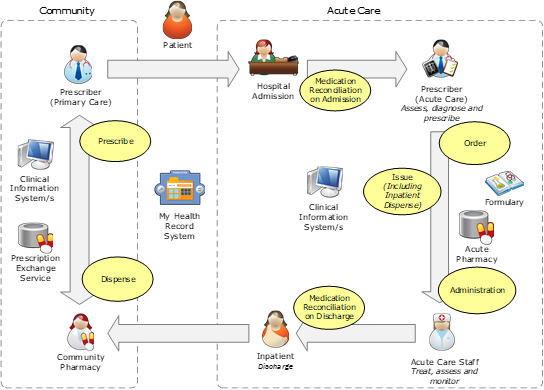

In action
There is a subset of SNOMED CT-AU called the Australian Medicines Terminology (AMT) which relates to medication. In Australia, many GPs use AMT-enabled prescribing systems to send medication data to AMT-enabled dispensing systems in pharmacies and hospitals. Information about a patient’s prescribed medicines is also captured in My Health Record.
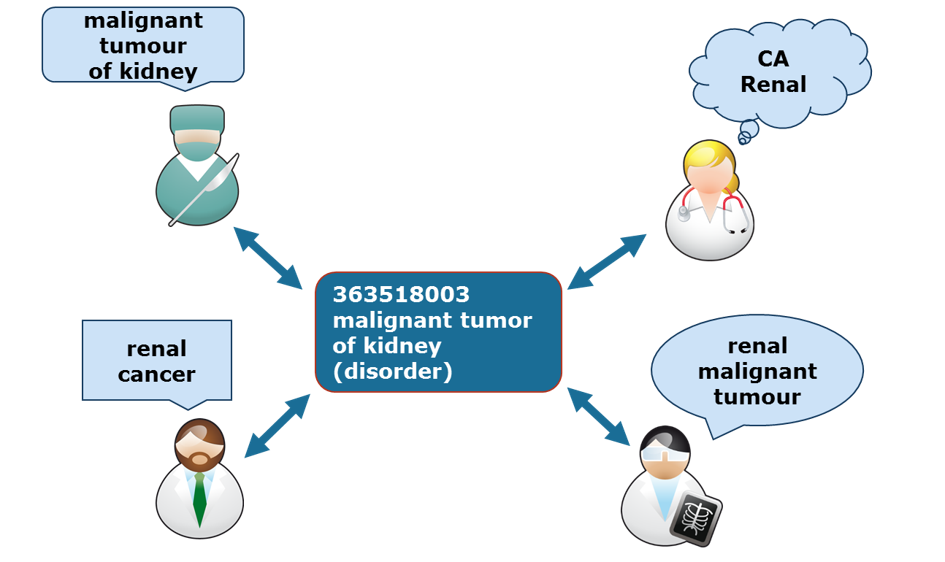
Synonyms in SNOMED CT allow healthcare professionals to search or enter medical terms that are familiar to them.
In this diagram, a doctor, a radiologist, a surgeon and a nurse enter different medical terms into different software systems. The terms look different but they all share the same meaning and link to the concept: 363518003 malignant tumor of kidney (disorder).
Conduct point of care, population and management analytics
SNOMED CT concepts (codes) are precise, clear, linked and they can be read and interpreted by computers. These links make SNOMED CT a powerful analytical tool for clinicians, epidemiologists, health managers and others with an interest in improving health.
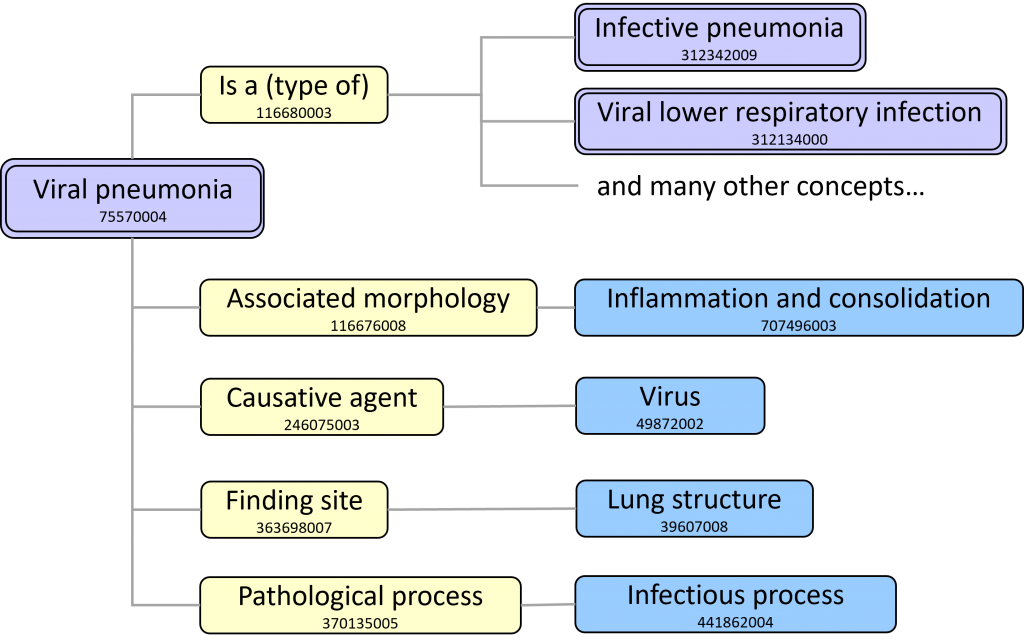
This diagram shows links in the software backend for the concept ‘viral pneumonia’. These links enable a user to find electronic health records containing ‘viral pneumonia’ by searching for:
- viral infection
- upper respiratory tract infection
- many other concepts such as ‘ear, nose and throat disorder’.
Using SNOMED CT’s linked concepts, health professionals and others can conduct many types of analysis.
Point of care analysis
Clinicians can use SNOMED CT to:
- create historical summaries
- conduct point of care reporting
- use clinical decision support.

In action
Sydney Adventist Hospital (The San) uses CliniSearch, developed by Health Language Analytics (HLA), to extract data from multiple sources and map it to SNOMED CT. This provides rich, precise information to the care team during patient discussions.
Population health analysis
Epidemiologists can use SNOMED CT to:
- conduct trend and comparative analysis
- monitor drug safety
- conduct clinical audits.

In action
Outcome Health developed a Population Level Analysis and Reporting tool (POLAR) using SNOMED CT. This tool allows GPs to gain insights to provide tailored care for their patients. It also provides patient data (identity details removed) to primary health networks for population health planning.
Organisational analysis by managers
Health managers can also use SNOMED CT to:
- conduct trend and comparative analysis
- conduct health system value analysis.

In action
HealthShare Victoria provides supply chain and procurement to Victoria’s public health service. HealthShare requests AMT (Australian Medicines Terminology – a subset of SNOMED CT-AU) codes as part of their procurement processes for pharmaceutical products. This enables them to analyse products quickly, consistently and accurately.
Conduct clinical, laboratory and scientific research
SNOMED CT concepts are precise, clear, linked and they can be read by computers, making it a powerful research tool.
Researchers can use SNOMED CT to:
- support a wide range of analytics and research activities
- accelerate the publication of research
- accelerate the actioning of their findings.
Importantly, SNOMED CT is mapped to other classification schemes. This enables researchers to quickly create data, evidence and knowledge.

In action
The Skin Health Institute redesigned their Skin Cancer Registry, which contained 17 years of free text data, to use SNOMED CT instead. This improved data quality, and made analysis simple and rapid. Using SNOMED CT enables researchers at the Skin Health Institute to easily identify specific patient groups and analyse which skin cancers and diseases they are diagnosed with in near real time.
Considering implementing
SNOMED CT-AU?
Healthcare providers and software vendors: please get in touch so we can advise on the best approach.

Call 1300 901 001
8am – 5pm (AEST/AEDT), Monday – Friday
